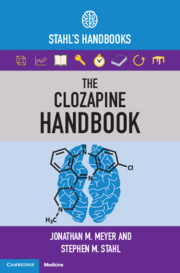Book contents
- The Clozapine Handbook
- The Clozapine Handbook
- Copyright page
- Additional material
- Contents
- Foreword
- Introduction
- 1 The Efficacy Story: Treatment-Resistant Schizophrenia, Psychogenic Polydipsia, Treatment-Intolerant Schizophrenia, Suicidality, Violence, Mania and Parkinson’s Disease Psychosis
- 2 Addressing Clozapine Positive Symptom Nonresponse in Schizophrenia Spectrum Patients
- 3 Initiating Clozapine
- 4 Discontinuing Clozapine and Management of Cholinergic Rebound
- 5 Binding Profile, Metabolism, Kinetics, Drug Interactions and Use of Plasma Levels
- 6 Understanding Hematologic Monitoring and Benign Ethnic Neutropenia
- 7 Managing Constipation
- 8 Managing Sedation, Orthostasis and Tachycardia
- 9 Managing Sialorrhea
- 10 Managing Seizure Risk and Stuttering
- 11 Managing Metabolic Adverse Effects
- 12 Fever, Myocarditis, Interstitial Nephritis, DRESS, Serositis and Cardiomyopathy
- 13 Managing Enuresis and Incontinence, Priapism, Venous Thromboembolism, Neuroleptic Malignant Syndrome, Tardive Dyskinesia and Obsessive Compulsive Disorder
- 14 Eosinophilia, Leukocytosis, Thrombocytopenia, Thrombocytosis, Anemia, Hepatic Function Abnormalities
- 15 Special Topics: Child and Adolescent Patients, Elderly Patients, Patients With Intellectual Disability, Pregnancy and Risk for Major Congenital Malformation, Lactation, Overdose, Postmortem Redistribution
- Index
- References
5 - Binding Profile, Metabolism, Kinetics, Drug Interactions and Use of Plasma Levels
Published online by Cambridge University Press: 19 October 2021
- The Clozapine Handbook
- The Clozapine Handbook
- Copyright page
- Additional material
- Contents
- Foreword
- Introduction
- 1 The Efficacy Story: Treatment-Resistant Schizophrenia, Psychogenic Polydipsia, Treatment-Intolerant Schizophrenia, Suicidality, Violence, Mania and Parkinson’s Disease Psychosis
- 2 Addressing Clozapine Positive Symptom Nonresponse in Schizophrenia Spectrum Patients
- 3 Initiating Clozapine
- 4 Discontinuing Clozapine and Management of Cholinergic Rebound
- 5 Binding Profile, Metabolism, Kinetics, Drug Interactions and Use of Plasma Levels
- 6 Understanding Hematologic Monitoring and Benign Ethnic Neutropenia
- 7 Managing Constipation
- 8 Managing Sedation, Orthostasis and Tachycardia
- 9 Managing Sialorrhea
- 10 Managing Seizure Risk and Stuttering
- 11 Managing Metabolic Adverse Effects
- 12 Fever, Myocarditis, Interstitial Nephritis, DRESS, Serositis and Cardiomyopathy
- 13 Managing Enuresis and Incontinence, Priapism, Venous Thromboembolism, Neuroleptic Malignant Syndrome, Tardive Dyskinesia and Obsessive Compulsive Disorder
- 14 Eosinophilia, Leukocytosis, Thrombocytopenia, Thrombocytosis, Anemia, Hepatic Function Abnormalities
- 15 Special Topics: Child and Adolescent Patients, Elderly Patients, Patients With Intellectual Disability, Pregnancy and Risk for Major Congenital Malformation, Lactation, Overdose, Postmortem Redistribution
- Index
- References
Summary
Clinicians must be knowledgeable about the mechanisms, metabolic pathways, and kinetics of all prescribed medications, but this is especially true for agents with narrower therapeutic indices such as clozapine. Armed with this information, one can maximize the potential for a successful clozapine trial in a patient who may lack other viable therapeutic options. While the properties underlying clozapine’s unique efficacy profile are not fully elucidated, there are extensive data on peripheral and central nervous system (CNS) kinetics, drug–drug and environmental interactions, and plasma levels to inform routine clinical care. (Throughout this volume clozapine plasma levels will be presented in ng/ml and nmol/l units. Some laboratories may report levels in μg/l, which is exactly equivalent to ng/ml.)
- Type
- Chapter
- Information
- The Clozapine HandbookStahl's Handbooks, pp. 90 - 113Publisher: Cambridge University PressPrint publication year: 2019



